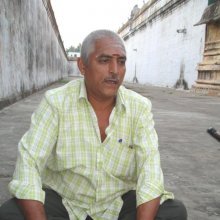Vellala, Veḷḷāḷa: 1 definition
Introduction:
Vellala means something in Hinduism, Sanskrit. If you want to know the exact meaning, history, etymology or English translation of this term then check out the descriptions on this page. Add your comment or reference to a book if you want to contribute to this summary article.
Images (photo gallery)
In Hinduism
Vaishnavism (Vaishava dharma)
Source: academia.edu: Dvādaśa-mūrti in Tamil TraditionVeḷḷāḷa (வெள்ளாள) refers to a “landlord” or “serf”.—[...] Nammāḻvār was known as Māṟan, Caṭakōpaṉ, Caṭāri and Tiruppuḷiyāḻvār. He was by birth a veḷḷāḷa (landlord or serf). He is considered a manifestation of Viṣvaksena, Tamil Cēṉai-mutaliyār. His disciple was Maturakavi, a Brāhmaṇa. Born in Kurukūr (modern Āḻvārtirunakari), a majestic temple of the Nāyaka period is today found in this city-like-village. Nearby nine Divyadeśas are located that are collectively known as Navatiruppati.

Vaishnava (वैष्णव, vaiṣṇava) or vaishnavism (vaiṣṇavism) represents a tradition of Hinduism worshipping Vishnu as the supreme Lord. Similar to the Shaktism and Shaivism traditions, Vaishnavism also developed as an individual movement, famous for its exposition of the dashavatara (‘ten avatars of Vishnu’).
See also (Relevant definitions)
Starts with: Vellalan, Vellalottam.
Full-text: Maturakavi, Tayumanavar, Tiruppuliyalvar, Maran, Catari, Catakopan, Cenaimutaliyar, Kurukur, Alvartirunakari, Nammalvar, Nilawasama, Pillai.
Relevant text
Search found 10 books and stories containing Vellala, Veḷḷāḷa, Vellāla, Vellaala; (plurals include: Vellalas, Veḷḷāḷas, Vellālas, Vellaalas). You can also click to the full overview containing English textual excerpts. Below are direct links for the most relevant articles:
Temples in and around Madurantakam (by B. Mekala)
The Vellalas < [Chapter 6 - Social and Economic Activities]
Merchants Communities < [Chapter 6 - Social and Economic Activities]
Social life and Communities of the Madurantaka region < [Chapter 6 - Social and Economic Activities]
The Religion and Philosophy of Tevaram (Thevaram) (by M. A. Dorai Rangaswamy)
Nayanar 12: Manakanchara (Manakkancarar) < [Volume 4.1.1 - A comparative study of the Shaivite saints the Thiruthondathogai]
Nayanar 34: Sakkiya (Cakkiya) < [Volume 4.1.1 - A comparative study of the Shaivite saints the Thiruthondathogai]
Nayanar 39: Kootruva (Kurruva) < [Volume 4.1.1 - A comparative study of the Shaivite saints the Thiruthondathogai]
Temples of Munnur (Historical Study) (by R. Muthuraman)
The Vellalas, the cultivators of Munnur society < [Chapter 2]
Introduction: Munnur Society < [Chapter 2]
Rajendra I (A.D. 1014-1044) < [Chapter 1]
Middle Chola Temples (by S. R. Balasubrahmanyam)
Temples in Attur < [Chapter II - Temples of Rajaraja I’s Time]
Appointment of Temple Servants and Administrative Arrangements < [Tanjavur/Thanjavur (Rajarajesvaram temple)]
Later Chola Temples (by S. R. Balasubrahmanyam)
Temples in (Ten-) Tiruvalangadu < [Chapter XII - Temples of Kulottunga III’s Time]
Temples in Tiruvalangadu < [Chapter II - Temples of Kulottunga I’s Time]
Temples in Melaperumballam < [Chapter IV - Temples of Vikrama Chola’s Time]
The Tamils and the Andhras < [July-September, 1928]
Remembering the Malgudi Man in His < [October – December, 2006]
Lakshmana Pillai, the Composer < [June 1937]
